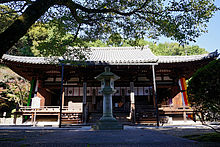Ryōsen-ji (Nara)
The Ryōsen-ji ( Japanese 霊 山寺 ) is a temple of the Shingon direction of Buddhism in the mountains on the eastern edge of the city of Nara .
history
At the request of the emperor Shōmu , priest Gyōki laid the temple in 736. Since the Indian monk Bodai Senna ( 菩提 僊 那 ) found that the mountain in the background resembled the Indian Ryōjusen ( 霊 鷲 山 ), the temple was called Ryōsen-ji.
In the Kamakura period , the Shikken Hōjō Tokiyori, who was very close to the Buddhist faith, took care of many temples, including the Ryōsen-ji. He renewed the main hall and put the whole temple area back in order. Toyotomi Hideyoshi and Tokugawa Ieyasu later supported the temple, which was elevated by the shogunate to a Goshuin ( 御 朱 印 ) temple, a temple that could issue confirmation of visits.
At the beginning of the Meiji period , however, the temple was heavily devastated under the motto “Away with Buddhism and Buddha” ( 廃 仏 毀 釈 , Haibutsu kishaku ) and lost 200 Buddhist sculptures. Much was restored in the Shōwa and Heisei times ; a work that continues to this day.
The attachment
A pilgrimage route lined with red-painted lanterns leads from the valley up to the temple, which is located in the middle of a forest of sickle firs . The impressive main hall ( Hondō ) from the Kamakura period is registered as a national treasure. Next to it is the bell tower ( Shōrō ) from the Muromachi period , which is registered as an important cultural asset .
On the other, southern side of the valley is the three-story pagoda ( 三重 塔 , Sanjū-no-tō ) from the Muromachi period (an important cultural asset).
Treasures of the temple
In the main hall there is a black lacquered shrine ( 黒 漆 厨子 , Kuro-urushi zushi ) from the Kamakura period, in which a Yakushi Buddha with two companions from the Heian period is kept. They were of particular importance for esoteric Buddhism, especially from the Jōgen period (976–978) to the Fujiwara period . There is also a wooden Shakamuni Buddha and the twelve heavenly generals from the temple and other treasures. These treasures of esoteric Buddhism are shown every year on the third Sunday in May as part of the “rose picture ceremony” ( 薔薇 絵 式 , Bara-e-shiki ). From October 23 to the second Sunday in November, a trinity from the treasury, Yakushi with two companions from the time of the north and south courtyards , will be shown. It is made of copper and, with a circumference of 1 m at the base, is one of the largest of its kind in Japan. A trinity of clay from the Nara period is also very old , which could perhaps come from the time before that, the Hakuhō period. All the mentioned cult objects are registered as valuable cultural property of Japan.
Remarks
- ↑ The grave of Bodai Senna is in the temple area.
literature
- Nara-ken kotogakko-kyoka token kenkyu-kyokai rekishi bukai (Ed): Ryosen-ji . In: Nara-ken no rekishi sampo (jo). Yamakawa Shuppan, 2010. ISBN 978-4-634-24629-4 . Pp. 100-102.
Web links
Coordinates: 34 ° 40 ′ 24.4 " N , 135 ° 44 ′ 32.6" E


